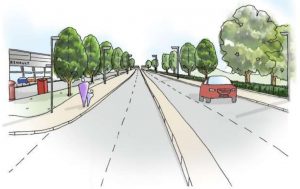A28 Chart Road work begins next week
 Preparation work for the widening of the A28 Chart Road in Ashford will begin next week (February 12).
Preparation work for the widening of the A28 Chart Road in Ashford will begin next week (February 12).
Kent County Council will then begin work on the £26 million project to widen Chart Road between the Tank and Matalan roundabouts in March and there will be further information provided about this stage of the works in due course.
The widening work is in preparation for the Chilmington Green development which will see around 5,750 homes being built over the next 25 years.
Vegetation and trees affected by the scheme are being cleared before the start of the bird nesting season.
The clearance will take about four weeks and stop and go boards will be necessary to manage traffic when vegetation close to the road is being cleared but this will be restricted to off-peak hours to minimise delays.
KCC will be providing replacement landscaping after the completion of the widening works that will see an increase in the overall number of trees along the route.
KCC will be providing a landscaping after the completion of the widening works that will see an increase in the overall number of trees along the route.
Rather than disposing of the wood, KCC will be creating opportunities for local charities and local craftspeople by reusing as much of the wood as practical.
More details will be provided shortly but if you know of a good cause in the area that could make use of the wood, contact the public liaison officer, Carole Jones at ChartRoadfeedback@jackson-civils.co.uk
Works are due to be completed by autumn 2019.
Kent County Council 07 February 2018
https://kccmediahub.net/a28-work-ashford-begins-next-week745








